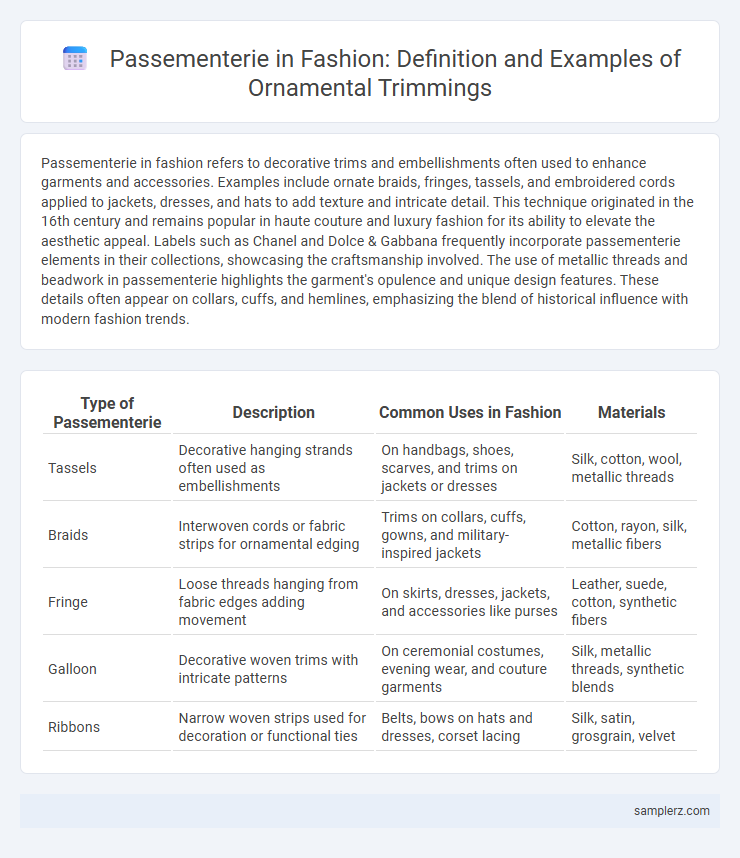Passementerie in fashion refers to decorative trims and embellishments often used to enhance garments and accessories. Examples include ornate braids, fringes, tassels, and embroidered cords applied to jackets, dresses, and hats to add texture and intricate detail. This technique originated in the 16th century and remains popular in haute couture and luxury fashion for its ability to elevate the aesthetic appeal. Labels such as Chanel and Dolce & Gabbana frequently incorporate passementerie elements in their collections, showcasing the craftsmanship involved. The use of metallic threads and beadwork in passementerie highlights the garment's opulence and unique design features. These details often appear on collars, cuffs, and hemlines, emphasizing the blend of historical influence with modern fashion trends.
Table of Comparison
| Type of Passementerie | Description | Common Uses in Fashion | Materials |
|---|---|---|---|
| Tassels | Decorative hanging strands often used as embellishments | On handbags, shoes, scarves, and trims on jackets or dresses | Silk, cotton, wool, metallic threads |
| Braids | Interwoven cords or fabric strips for ornamental edging | Trims on collars, cuffs, gowns, and military-inspired jackets | Cotton, rayon, silk, metallic fibers |
| Fringe | Loose threads hanging from fabric edges adding movement | On skirts, dresses, jackets, and accessories like purses | Leather, suede, cotton, synthetic fibers |
| Galloon | Decorative woven trims with intricate patterns | On ceremonial costumes, evening wear, and couture garments | Silk, metallic threads, synthetic blends |
| Ribbons | Narrow woven strips used for decoration or functional ties | Belts, bows on hats and dresses, corset lacing | Silk, satin, grosgrain, velvet |
Defining Passementerie: Origins and Evolution in Fashion
Passementerie, a decorative art form originating in 16th-century Europe, involves intricate trims and embellishments such as tassels, braids, and fringes that enhance garments' visual appeal and texture. Initially used in royal courts to signify status, passementerie evolved through centuries, influencing fashion designers and couture houses by adding luxurious detail to collars, cuffs, and hemlines. Modern fashion integrates passementerie in accessories and apparel to blend historical craftsmanship with contemporary style, emphasizing both heritage and opulence.
Tassels and Fringe: Classic Passementerie Accents
Tassels and fringe exemplify classic passementerie accents in fashion, elevating garments with intricate decorative details. Historically used in high-end couture, these embellishments add texture and movement to jackets, dresses, and accessories. Contemporary designers incorporate tassels and fringe to evoke vintage elegance while enhancing visual appeal and tactile interest.
Embroidered Braids: Ornate Trims on Garments
Embroidered braids are exquisite passementerie elements that enhance the aesthetic value of garments by adding intricate, ornamental trims often crafted with metallic threads, beads, or silk. These decorative braids are commonly found on luxury fashion items such as military-style jackets, haute couture gowns, and traditional folkloric costumes, offering a textured richness and historical elegance. The use of embroidered braids in fashion not only accentuates the silhouette but also reflects artisanal craftsmanship and cultural heritage.
Gimp and Galloon: Decorative Borders in Couture
Gimp and galloon serve as iconic examples of passementerie in high fashion, providing decorative borders that enhance couture garments with intricate texture and visual appeal. Gimp, a narrow, ornamental trim woven with raised patterns, is often used to outline collars, cuffs, and seams, adding elegance and dimensionality to fabrics such as silk or velvet. Galloon, characterized by its wide, woven metallic or embroidered band, frequently embellishes evening gowns and jackets, creating bold, luxurious accents that reflect light and underscore craftsmanship in designer collections.
Corded Details: Elevating Modern Design
Corded details in fashion passementerie embody intricate craftsmanship, offering textured embellishments that enhance garments with sophistication and depth. Designers integrate corded trims along hemlines, collars, and sleeves to create visually striking accents that elevate modern apparel. This technique combines traditional needlework with contemporary aesthetics, making corded passementerie a distinctive feature in couture and ready-to-wear collections.
Beaded Passementerie: Sparkling Embellishments
Beaded passementerie in fashion showcases intricate craftsmanship with shimmering beads meticulously sewn onto garments, creating dazzling patterns and textures. This technique enhances evening gowns, bridal wear, and haute couture with sparkling embellishments that catch and reflect light, adding undeniable glamour. Renowned designers like Elie Saab and Marchesa frequently incorporate beaded passementerie to elevate their collections' elegance and sophistication.
Ribbon Work: Soft and Structured Applications
Ribbon work in passementerie enhances fashion pieces through soft, flowing embellishments or structured, geometric designs, adding depth and texture to garments. Delicate silk ribbons entwined with metallic threads create luxurious trims on haute couture dresses, while firmer grosgrain ribbons form bold patterns and shapes on jackets and accessories. These versatile ribbon applications elevate fashion by combining tactile richness with intricate craftsmanship.
Passementerie in Historic Costumes
Passementerie in historic costumes often features elaborate braids, fringes, and tassels made from silk, gold, or silver threads, enhancing the luxurious appeal of garments worn by nobility during the Renaissance and Baroque periods. These ornamental trims adorned doublets, gowns, and cloaks, serving as markers of status and craftsmanship in European court fashion. The intricate designs of passementerie reflected regional styles and were crucial in costume preservation and historical reenactments.
Contemporary Designers Reviving Passementerie
Contemporary designers like Iris van Herpen and Dries Van Noten are reviving passementerie by integrating elaborate braided trims and ornamental tassels into their modern collections. These intricate embellishments enhance garment texture and elevate luxury appeal in runway fashion. The resurgence of passementerie reflects a broader trend toward artisanal craftsmanship and detailed ornamentation in contemporary design.
How to Incorporate Passementerie in Everyday Wear
Incorporate passementerie in everyday fashion by selecting blouses or jackets adorned with intricate braided trims, tassels, or fringes that elevate a simple outfit without overwhelming it. Choose accessories such as scarves or handbags featuring subtle beaded or corded detailing to add texture and sophistication to casual looks. Opt for neutral or complementary colors in passementerie to seamlessly blend with your wardrobe while maintaining a chic, polished appearance.

example of passementerie in fashion Infographic
 samplerz.com
samplerz.com